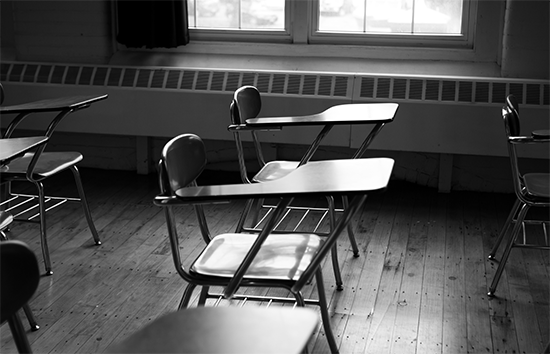





"He Has a Gun!"
By Eric K. Thomsen
When a student interrupted her Wednesday morning planning breakfast in a coworker’s office, Molly, an energetic middle school counselor from Tennessee was unfazed. Such interruptions are nothing unusual in a job where students with problems and concerns are the norm, not the exception. “You go on over to my office,” she told him. “I’ll be right behind you.”
After gulping down a few remaining crumbs and excusing herself, Molly followed the young man down the hall, through the counseling department, to her office. She went in and closed the door behind her, just as she had a thousand times before. Settling into her desk chair, she glanced at the clock—8:10 a.m. She had no idea it was the moment her life would change forever.
The student perched nervously on the chair across the desk, pale and sweating, coat zipped all the way to his chin. His words came in a rush, and after a few minutes of conversation, he began asking a series of alarming, even chilling questions. “I knew immediately something was deadly wrong,” Molly recalls. A warm, numbing sensation began to creep downward from the top of her head, and she fought the urge to pass out as something told her, “He has a gun!”
As if reading her mind, the obviously agitated student began tapping on something in his coat. A moment later, he pulled out a 45-caliber Taurus handgun and laid it on the desk, along with a loaded clip. “I remember thinking ‘I am going to die in this office,’” Molly recalls. “‘The day before my 40th birthday, and I am going to die, right here, in this palm tree skirt.’”
Yet, along with that random thought came another, much more powerful thought: “For such a time as this.”
Counselor Under Construction
Molly always wanted to be in education. As early as second grade, she told her mom she wanted to be a school psychologist. “I have no idea where that came from,” she laughs. “I never even had a school counselor, and I’m pretty sure I had no idea what one did.”
After high school, Molly enrolled at Western Kentucky University to study English. Though she enjoyed her college years, it isn’t the educational experience she recalls most vividly. During a quiet evening of study her junior year, the FBI showed up at the door of her night class. Someone had called in a bomb threat, and not just to any room—to Room 502—her room. The agents quickly hustled Molly from the area and subjected her to thorough questioning. The caller was never identified. And Molly was never the same.
The event terrified Molly. She began reading about violence and crisis prevention, and she took a self-defense class. She never went anywhere alone, and obtained a license to carry a gun. From that moment, she lived with fear and anger and wanted to be ready to protect herself.
As college graduation drew near, Molly began to wonder what was next. A teacher in a senior-level class called Marriage and Family pointed the way when she urged her to become a therapist. The advice struck a chord. Molly immediately enrolled in a master’s program for marriage and family therapy. She laughs as she recalls that “halfway through the first year, I realized, ‘I’m studying to be a marriage and family therapist. I’m 21-years-old, unmarried, with no kids. Really? Who’s going to listen to me?’”
The Teacher Transition
Degree in hand, Molly returned to her original career choice—the classroom. For eight wonderful years, she dedicated her life to her students. She smiles at the memory. “I loved those children as much as you can love kids that aren’t your own.” And her love for students showed. She was a good teacher. Her students tested well, even though she admits she had no idea about the standards she was supposed to be teaching. “The truth is,” Molly confesses, “I didn’t know what I was doing, but the Holy Spirit was working in and through me. My students and their parents sensed it, and they gravitated toward it.”
Later, students recalled her “taking prayer requests,” even though Molly never prayed or asked students to share requests in class. She simply cared, and it showed when she allowed students to share struggles they were having or about loved ones going through difficulties. “I think I was a good English teacher,” she muses, “but all the time, God was preparing me to be an even better counselor.”
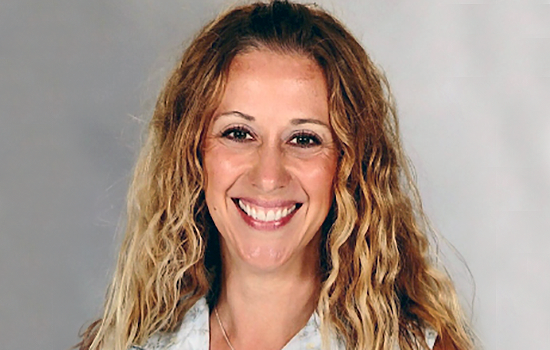
Photo: Molly Hudgens, 2017.
As she settled into her life and career, Molly never lost her preoccupation with crisis and trauma. After the tragedy at Columbine in 1999, her first year in the classroom, she became fixated. She just couldn’t understand how two young boys could plan and carry out an attack so massive and deadly without anyone identifying any signs of their plans. She continued her research but turned her focus specifically to school violence. She developed a curriculum called Recognizing Red Flags: An Educator’s Role in Preventing School Violence to help teachers and faculty members identify students with the potential for deadly behavior. With occurrences of school violence rising steadily, before long, Molly’s curriculum reached beyond school campuses, and she found herself training law enforcement officers and first responders.
The classroom also gave Molly plenty of hands-on experience with kids in crisis. She learned a whistle is an effective tool for breaking up fights. She learned to be firm yet still let kids know she cared. Two crucial events shaped her final year in the classroom. First, she received a call from Pam, a student’s mother who had been diagnosed with a rare form of cancer. Pam wanted Molly to know her son Danny would need extra help and understanding while she endured out-of-state treatments. Molly stepped up and experienced the joy of guiding and encouraging a student through overwhelming circumstances.
The second was a fight, a pre-planned fight between older students that resulted in severe injuries and made the local news. After helping break up the fight, Molly remembers going to the bathroom and “bawling my eyes out.” In that moment, she made up her mind it was her last year as a teacher. After talking it over with a good friend and mentor, she followed her heart for kids into counseling.
The Rookie
During her first day on the job, Molly had no idea what to do, so she fielded every phone call that came into the school counseling office. Before long, the empty days filled up. She learned a school counselor is a catchall; she never knew what she would face next. More than anything else, Molly learned a counselor has a thousand conversations with students about anything and everything—some goofy, some serious, and some heartbreaking. She learned to meet students at their point of need.
Molly quickly grew to love her new role, making a difference in the lives of students on a personal, one-to-one level. She relished every opportunity. She also began to teach classroom guidance lessons, delivered from the perspective of a counselor but linking important life lessons to a particular area of study. During the 2015 school year, Molly realized many of her students hadn’t been born when 9-11 occurred, so, she prepared a lesson based on the life of Welles Crowther, one of the heroes of the World Trade Center. An equities trader in the second tower, Welles led many people to safety before losing his own life in the raging inferno. Molly called the lesson “The Man in the Red Bandana” and concluded by challenging students to consider what they could do to make the life of someone else better.
In response, several football players went to their coach and asked him to help their equipment manager, a special-needs student, score a touchdown. The coach agreed, and the young man was given the opportunity of a lifetime. He suited up with the rest of the guys for the next game. And, with some help from the other team, he crossed the goal line to the roars of the crowd.
Touched by her students’ actions, Molly shared the story with the race coordinator of a 5K held at Boston College to honor Welles Crowther. When the hero’s mother heard the story, she responded with a personal letter. The students were awed by the response, and Molly made up her mind to use life character curriculum provided by the Welles Crowther Foundation to teach additional lessons.
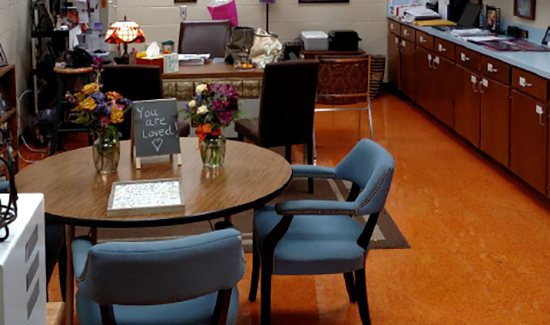
Photo: Molly's counseling office.
On September 27, 2016, Molly taught the first lesson titled, “One Life Can Make a Difference.” She had students write down what they would be willing to do to influence the life of another person. She concluded each of her six classes that day with the words, “Sometimes, you have to stand in the gap with other people, but there will come a time when no one else is there, and you have to stand all by yourself.” She had no idea those words were prophetic.
September 28
The day began like any other. Molly was up early, running, training for her first marathon. She remembers seeing fog rising from the water in the family pool and thinking fall was coming. She recalls standing before her full-length mirror and wondering, “Is it too late in the year to wear a skirt with palm trees on it?” Yet, beyond those simple memories, nothing about the day stands out to Molly before the moment when the gun clunked on her desk.
In that moment, everything changed. As time stood still, Molly finally understood—the childhood desire to work in a school setting, the terrifying experience in college, the near-obsession with school shootings, the thousands of pages of research, the training curriculum she had written and taught, the fight she had broken up, the story of Welles Crowther and his courage, the thousands of conversations with troubled students. For the first time, everything made sense. Her entire life, God had been at work in her, preparing her for “such a time as this.”
“Suddenly, something rose up in me,” Molly recalls. I remember thinking, ‘Not at my school! Not today. No shots fired. No lives lost.’” With every cell in her brain screaming, “Run! Run! Run!” she made the choice to stay, to fight with the tools God had been giving her all along. With heart pounding and mind racing, she calmly looked across the desk and said, “Honey, why don’t you give me the gun, and then we’ll talk.”
The student quickly drew the gun and clips back from the desk, but he didn’t make a threatening gesture. He simply settled back in his chair, put the clip and magazine in his coat, and let the weapon dangle loosely in his left hand. Against all laws of nature, Molly stood up and stepped around the desk, moving closer to the student. She got down on her knees beside him, looked into his eyes, took his right hand, and intertwined the fingers of her right hand with his. “I made the conscious decision not to contact anyone else. I decided the best chance of survival for all of us was to get him to talk to me, to convince him to give me the gun. But, if that didn’t work, I wanted to be close enough to grab the gun and fight for my life.”
Molly knew that in a few short minutes, classes would change and teachers would enter her office. It was possible an interruption would agitate the troubled, young man and trigger him to react negatively. She had to talk and talk quickly. So, she began to talk for her life. As she talked, she couldn’t help but see the pictures of her family and friends in the background, a reminder of all the reasons she wanted to live.
As the student’s story tumbled out, Molly quickly realized that several events in the young man’s life had converged into the “perfect storm” of anger, desperation, and confusion. She instinctively knew he wasn’t always this way, and prayed she could help him.
Suddenly, the student looked up at Molly and asked her if she believed in God. At that moment, remembering Columbine, Molly thought, “Dear God, he’s going to shoot me!” Yet, in spite of her terror, she replied, “Well, honey, I do, but I feel like you don’t. Is there something that has made you feel this way?”
He replied by explaining he had asked for help many times, and God had never answered. Molly responded simply, “Honey, what do you think this is?”
She asked for the gun again, as she did many times during the encounter. Again, he refused. Molly asked if she could pray with him; he agreed. She recalls that prayer as if it were yesterday. “I prayed the most heartfelt prayer of my life. I thanked God for him. I thanked Him for bringing him to my office that day. I begged God to wrap His arms around him and help him feel His presence. I prayed knowing prayer was my only hope.” As she prayed, Molly remembers a strong and calming pressure at her back, as if someone was physically touching her.
After praying with the student, Molly could sense a change, and she asked God for an opening. When the student noticed a race medal hanging on her wall, she sensed it was the opportunity for which she had been praying. She explained her marathon training was wreaking havoc on her knees. The student told her she could return to her desk, that he knew she was uncomfortable kneeling beside him. Typical Molly, she told him, “I’m not getting up from this position—no matter how much my knees hurt—until you give me that gun.”
The switch flipped, and he told her he wanted to give her the gun. She replied. “Well, why don’t you let me take it, and then you won’t have to give it to me.” He reached over and put the safety on, and Molly leaned over and took it from him.
It was the first time a teacher or school official had encountered an armed student who came to campus with the means, opportunity, plan, and potential victims but instead went to a staff member and said, “I came to you, because you are the only person who can talk me out of this.”
Gun surrendered, the student threw his arms around Molly and began crying. She told him to go ahead and cry, that it would be okay; that he had done the right thing, and she was proud of him. The hug lasted three solid minutes as Molly ticked off the seconds on the large clock across the office. She remembered someone telling her that if a child hugs you, never let go until the child does. She refused to let go.
When he finally released her, the student also gave Molly the loaded ammunition clip, and she calmly locked everything in her filing cabinet. She returned to the chair beside the student, and they continued their conversation. While neither the student nor Molly knew what the end result would be, he understood law enforcement had to be contacted.
A few minutes later, first responders completed a gracious and compassionate interrogation. “For all the people who are angry at the police today,” Molly notes, “I wish they could have been there. Those officers were wonderful!” Interestingly enough, every first responder on the scene had been through Molly’s crisis training courses, more evidence of God’s hand at work.
The Aftermath
What does one do after talking the gun from the hand of a potential shooter? While the school remained on lockdown, Molly quietly took orders from police officers and made a Taco Bell run. She stayed at work the rest of the day and went right back to work the following morning.
The media began to contact the school system, demanding an interview. Molly refused. She recorded a simple statement and let it go at that. She wanted parents to know that if it was okay for her to be at school, it was okay for their kids to be at school.
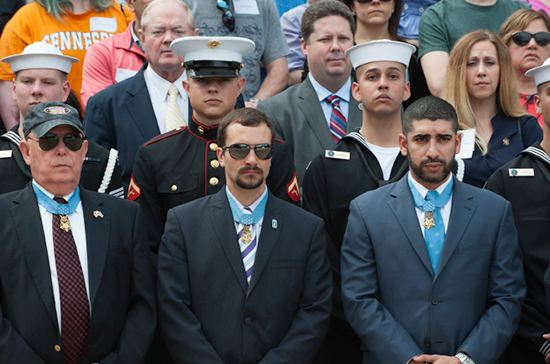
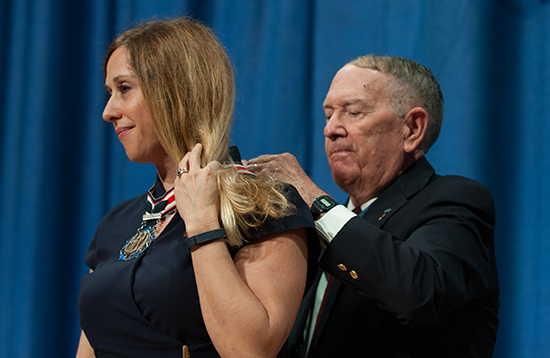
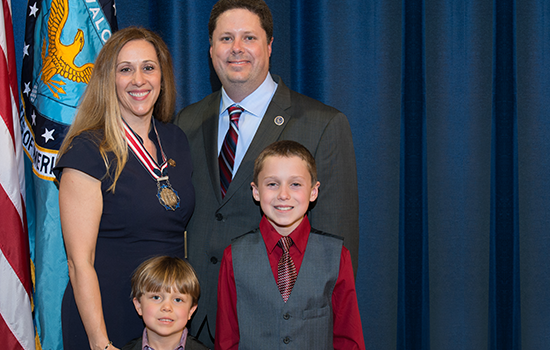
Photos: Molly attends the Medal of Honor ceremony at Arlington, receives the medal, and poses with her family. Images courtesy of the Congressional Medal of Honor Foundation.
The frustrated media outlets created their own stories. Rumors swirled, and some hurtful, misleading things were published. But Molly was okay. She met with students, parents, and teachers. As a school family they healed together. “For all the painful things I heard and read,” Molly notes, “I received a thousand other words of encouragement—cards from all over the U.S. and from as far away as China.”
In hindsight, Molly understands that God had been working in her life in a mighty way in those weeks prior to September 28. The previous Sunday, Cecil Boswell, her pastor at Friendship FWB Church, preached a message titled, “Watch and See What God Is About to Do.” The morning of the crisis, an enormous turnout of students had gathered early at school for See You at the Pole, to pray for their school and teachers. Their theme? “Watch and See.” That week, Jeremiah 29:11 was inscribed across the bottom of her school planner: “I know the plans I have for you.” The list goes on and on.
Remember Danny, the student from Molly’s last year of teaching? As a senior, he had been assigned to her as a student assistant. With Molly’s encouragement, he applied for and was accepted to West Point. To say thank you, he painted a lighthouse to represent the counseling office motto: This is your safe harbor in time of storm. In his painting, the lighthouse didn’t shine out over water but stood alone, in the middle of a field. At the time, Molly thought it strange. Looking back, she sees the painting as a visual representation of what God did in her office that day.
After a few weeks, Molly and her family took some time away at the beach. One morning at sunrise, Molly found herself on the edge of the water. Kneeling, she scratched the date of September 28 in the sand and began to pray: “Lord, I want you to take this from me. I will not suffer from Post Traumatic Stress Syndrome, and I don’t want to be a victim—I want to be a survivor. Help this incident not to define me, but allow me to define it.” She took a picture (below) of her toes in the sand and sent it to the school staff in an email with the subject heading “It Is Well With My Soul.”
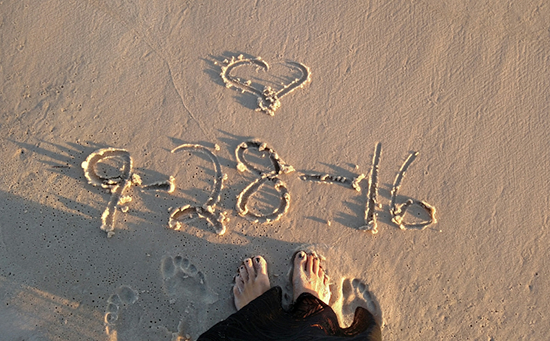
A Year Later
Soon after Molly returned to work, a steady stream of recognition began. The state of Tennessee awarded her valor. Her hometown named her marshal of the local Christmas parade. The attention was both humbling and embarrassing for Molly.
In January, she was contacted by the Congressional Medal of Honor Foundation and notified she had been nominated to receive the 2017 Citizen’s Honor, one of a handful awarded each year, and often posthumously. In February, she was notified she had been named as a recipient. The call came during her mother’s bilateral mastectomy. “When Mom woke up, I told her ‘Mama, I am going to be a recipient of the Citizen’s Honor, and you don’t have cancer anymore. It’s a great day!’” Her mom later told her that moment helped serve as a distraction during her cancer crisis.
Molly traveled to Arlington National Cemetery March 25 to accept the award. At first, she felt ill at ease among the heroes at the gathering, but they quickly let her know she was right where she belonged. She was almost overwhelmed when she learned she was only the tenth female awarded the medal. Seven of the women were educational recipients who died because of their courageous actions. Six were educators killed at Sandy Hook Elementary School in Newtown, Connecticut, in December 2012. The seventh was a crossing guard in Boston, Massachusetts, who pushed a child out of the way of an oncoming car and was struck and killed.
A year behind her, Molly looks back on the experience with a new perspective. “What I know is that many years ago, I asked God to forgive me, to come into my life, and to save me. On September 28, 2016, I asked for help, and once again, He delivered me.”
What about the troubled young student she faced that day in her office? Molly holds no anger or resentment. “I am not aware of another time in school history when a student had the means, the motive, and the intended victims, yet chose to ‘stand in the gap’ for himself, made a decision to seek help, and ultimately saved his life and the lives of many around him. I will always be proud of him for choosing to do what was right above all else.”
Molly believes the young man has a powerful story to tell someday about standing on the ragged edge of a precipice and making the decision to turn away. “His story is an inspiration to others who are feeling alone and facing uncertainty due to trials,” she concludes. “God is good, and because of Him, we always have hope.”
About the Writer: Eric K. Thomsen is managing editor of ONE Magazine and president of the Evangelical Press Association.
|

